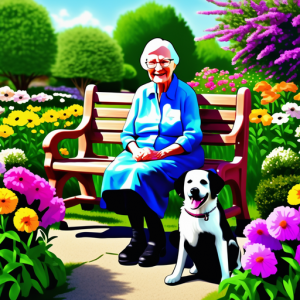As we journey through the natural process of aging, we encounter a multitude of changes—physically, emotionally, and psychologically. For many seniors, maintaining a sense of purpose and joy can become an uphill task as they navigate this phase of life. Thankfully, a heartwarming and scientifically validated solution has gained considerable recognition in recent times: the healing power of pet companionship. At Assisting Hands Home Care in North Texas, we are strong proponents of holistic care that transcends conventional methods. In this article, we will delve into the incredible advantages of pet companionship for elderly individuals, exploring how the presence of furry friends can contribute to a happier, healthier, and more fulfilling life.

The Science Behind Pet Companionship
Pet companionship, often referred to as animal-assisted therapy or AAT, involves the use of animals in a structured manner to enhance physical, social, emotional, and cognitive well-being. While the concept of animals positively impacting human lives has deep historical roots, modern research has illuminated the biochemical and psychological mechanisms that make pet companionship a potent tool, particularly for seniors.
Interacting with animals triggers the release of oxytocin, commonly known as the “bonding hormone” or “love hormone.” Oxytocin fosters feelings of trust, empathy, and emotional attachment. Moreover, the act of petting a dog or cat has been proven to lower cortisol levels, which are associated with stress. This physiological response can have a profound effect on elderly individuals who may be grappling with feelings of isolation, anxiety, or depression.
Here are the 7 Benefits of Companion Pets for Seniors
- Alleviating Loneliness through Companionship: One of the most significant challenges faced by seniors is social isolation and loneliness, which can have detrimental effects on both mental and physical health. The presence of a furry companion can offer a steady source of companionship, reducing feelings of loneliness and instilling a sense of purpose.
- Encouraging Physical Activity and Mobility: Pets, particularly dogs, encourage physical activity through activities like walking and engaging in play. Participating in these activities can lead to improved cardiovascular health, enhanced mobility, and even effective weight management.
- Stimulating Cognitive Functions: Interaction with pets stimulates cognitive functions, including memory and problem-solving skills. The responsibilities associated with pet ownership, such as adhering to feeding schedules and grooming routines, help keep the mind agile and involved.
- Boosting Emotional Well-being: The act of petting and cuddling animals triggers the release of endorphins, which act as natural mood elevators. This can lead to a reduction in symptoms associated with depression and anxiety, ultimately fostering emotional well-being.
- Facilitating Social Interaction: Pets can serve as social catalysts, initiating conversations and connections between seniors and others. Taking a dog for a stroll, for instance, frequently leads to interactions with neighbors and fellow pet enthusiasts.
- Establishing Routine and Structure: Instituting a routine centered around pet care can introduce a sense of structure and predictability to seniors’ lives. This is particularly valuable for those who may have experienced significant life changes or the loss of a spouse.
- Inculcating a Sense of Responsibility: Caring for a pet imparts a sense of responsibility and purpose, providing seniors with a reason to start their day and actively partake in daily tasks.
Selecting the Ideal Pet
While the advantages of pet companionship are evident, it is crucial to select a pet that aligns with the senior’s lifestyle, preferences, and capabilities. Several factors warrant consideration:
- Size and Activity Level: Seniors should opt for a pet that matches their physical capacities. For instance, a high-energy dog might not be suitable for an individual with limited mobility.
- Allergies and Sensitivities: Any allergies or sensitivities the senior may have should be taken into account. Certain animals, such as hypoallergenic dog breeds or specific types of cats, may be better suited.
- Grooming Requirements: Pets with long coats might necessitate more grooming, which could impact seniors who prefer low-maintenance companions.
- Living Arrangements: The senior’s living situation, whether in their own home or an assisted living facility, may influence the type of pet that is feasible.
- Disposition: A calm and gentle disposition is essential, particularly if the pet is intended to provide emotional support.
At Assisting Hands Home Care, we recognize the significance of this decision and are well-equipped to assist seniors and their families in evaluating their options and making informed choice that aligns with their unique circumstances.
Integrating Pet Companionship with Seniors
Introducing a pet into a senior’s life requires thoughtful planning and consideration. Here are a few steps to ensure a smooth transition:
- Consultation with Healthcare Professionals: Before introducing a pet into the home, it is advisable to consult the senior’s healthcare provider. They can offer insights into potential health considerations or concerns.
- Choosing the Right Pet: As previously mentioned, selecting an appropriate pet is pivotal. Consider adopting from a shelter or rescue organization, as older animals might be better suited for the senior’s lifestyle.
- Pet-Proofing the Living Space: Ensuring a safe and pet-friendly environment is crucial. This entails eliminating hazards, securing cords, and creating designated areas for the pet.
- Training and Socialization: Adequate training and socialization are essential for both the pet and the senior. If necessary, enroll the pet in obedience classes and encourage positive interactions between the senior and the animal.
- Regular Veterinary Care: Seniors should establish a relationship with a veterinarian to ensure their pet receives routine check-ups and vaccinations.
- Physical Engagement: Engaging in age-appropriate physical activities with the pet, such as short walks or gentle play sessions, fosters a stronger bond and overall well-being.
- Supervision and Support: Monitor the senior’s interactions with the pet closely and observe any changes in behavior or health. Family members or caregivers should provide ongoing assistance.
Assisting Hands Home Care: Your Partner in Comprehensive Support
At Assisting Hands Home Care in North Texas, we comprehend the distinctive needs of seniors and the transformative influence of pet companionship. Our team is dedicated to delivering personalized home care that encompasses the physical, emotional, and psychological welfare of our clients. As part of our home health care services, we offer guidance and assistance in integrating pet companionship into seniors’ lives, guaranteeing a seamless and enriching experience.
We firmly believe that every senior deserves to experience a life brimming with happiness, purpose, and companionship. Through our all-encompassing approach to in-home care, we are resolute in making this vision a reality.
As we navigate the intricate path of aging, finding sources of comfort and joy becomes imperative. Pet companionship, with its profound physical, emotional, and cognitive advantages, has emerged as a heartening and effective solution for seniors. The presence of a furry friend can alleviate loneliness, stimulate physical activity, invigorate the mind, and contribute to emotional well-being.
At Assisting Hands Home Care in North Texas, we acknowledge the immense value that pet companionship brings to the lives of older individuals. That is why, our in-home caregivers play a vital role in enabling elderly individuals to experience the advantages of having pets, offering essential assistance to overcome challenges associated with aging.








